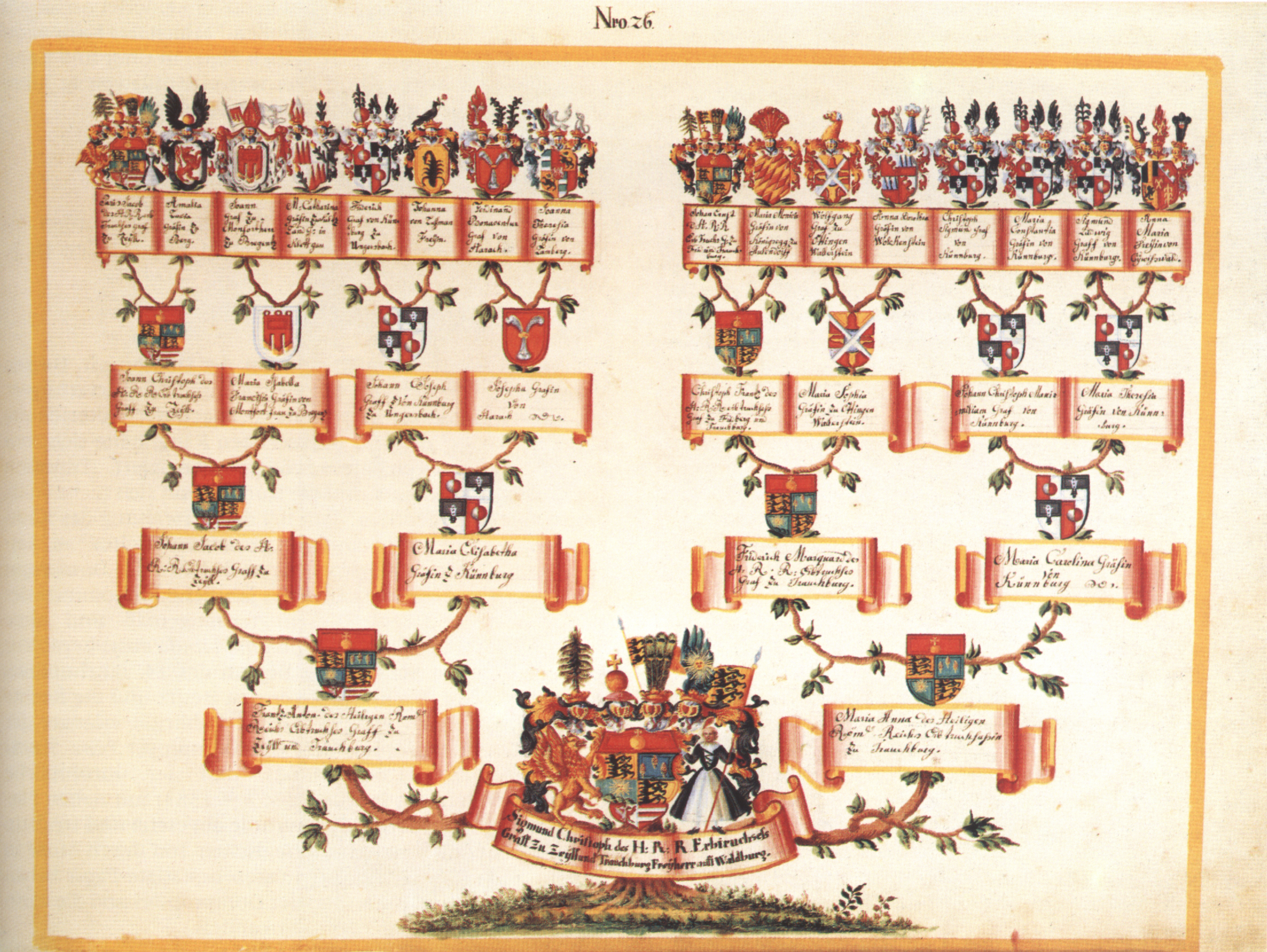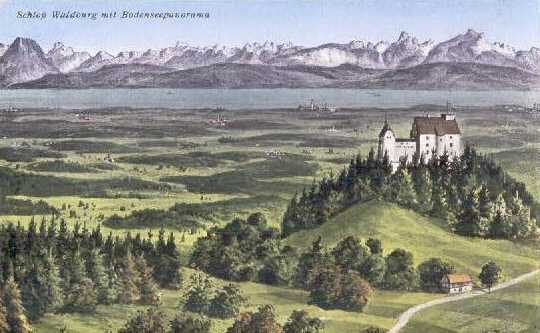|
Sigmund Christoph Von Waldburg-Zeil-Trauchburg
Sigmund Christoph von Waldburg-Zeil-Trauchburg ( Munich, 28 August 1754 - Salzburg, 7 November 1814) was a German Roman Catholic bishop. He was the last bishop of Chiemsee and apostolic administrator of Salzburg. See also * Waldburg family The House of Waldburg is a princely family of Upper Swabia, founded some time previous to the 12th century; some cadet lineages are comital families. Eberhard von Tanne-Waldburg (? - 1234) was the steward, or '' seneschal'', and adviser of the ... Notes References * * 1754 births 1814 deaths People from Munich People from the Electorate of Bavaria German nobility 19th-century German Roman Catholic bishops {{Germany-RC-bishop-stub ... [...More Info...] [...Related Items...] OR: [Wikipedia] [Google] [Baidu] |
Waldburg Ahnentafel Sigmund Christoph Von Waldburg
Waldburg is a town in the district of Ravensburg in Baden-Württemberg in Germany. It is the home of Waldburg Castle, a medieval castle that sits atop the large hill in the town. The castle dates from the twelfth century, when Waldburg was a County of the Holy Roman Empire. House of Waldburg In 1424, the county was partitioned: * Waldburg-Sonnenburg, annexed by Austria, 1511 * Waldburg-Trauchburg, partitioned in 1504: ** Waldburg-Capustigall, annexed by Prussia, 1745 ** Waldburg-Trauchburg, partitioned in 1612: *** Waldburg-Friedburg-Scheer Waldburg-Friedburg-Scheer was a County ruled by the House of Waldburg, located in southeastern Baden-Württemberg, Germany. Waldburg-Friedburg-Scheer was a partition of Waldburg-Trauchburg Waldburg-Trauchburg was a County within Holy Roman Empir ..., restored in 1717 *** Waldburg-Trauchburg, partitioned in 1717: **** Waldburg-Scheer, restored in 1764 **** Waldburg-Trauchburg, annexed by Waldburg-Zeil, 1772 * Waldburg-Wolfegg ... [...More Info...] [...Related Items...] OR: [Wikipedia] [Google] [Baidu] |
Munich
Munich ( ; german: München ; bar, Minga ) is the capital and most populous city of the States of Germany, German state of Bavaria. With a population of 1,558,395 inhabitants as of 31 July 2020, it is the List of cities in Germany by population, third-largest city in Germany, after Berlin and Hamburg, and thus the largest which does not constitute its own state, as well as the List of cities in the European Union by population within city limits, 11th-largest city in the European Union. The Munich Metropolitan Region, city's metropolitan region is home to 6 million people. Straddling the banks of the River Isar (a tributary of the Danube) north of the Northern Limestone Alps, Bavarian Alps, Munich is the seat of the Bavarian Regierungsbezirk, administrative region of Upper Bavaria, while being the population density, most densely populated municipality in Germany (4,500 people per km2). Munich is the second-largest city in the Bavarian dialects, Bavarian dialect area, ... [...More Info...] [...Related Items...] OR: [Wikipedia] [Google] [Baidu] |
Salzburg
Salzburg (, ; literally "Salt-Castle"; bar, Soizbuag, label=Bavarian language, Austro-Bavarian) is the List of cities and towns in Austria, fourth-largest city in Austria. In 2020, it had a population of 156,872. The town is on the site of the Roman settlement of ''Iuvavum''. Salzburg was founded as an episcopal see in 696 and became a Prince-Archbishopric of Salzburg, seat of the archbishop in 798. Its main sources of income were salt extraction, trade, and gold mining. The fortress of Hohensalzburg Fortress, Hohensalzburg, one of the largest medieval fortresses in Europe, dates from the 11th century. In the 17th century, Salzburg became a center of the Counter-Reformation, with monasteries and numerous Baroque churches built. Historic Centre of the City of Salzburg, Salzburg's historic center (German language, German: ''Altstadt'') is renowned for its Baroque architecture and is one of the best-preserved city centers north of the Alps. The historic center was enlisted as a UN ... [...More Info...] [...Related Items...] OR: [Wikipedia] [Google] [Baidu] |
Bishop Of Chiemsee
The Bishopric of Chiemsee was a Roman Catholic diocese. While based on the islands of the Chiemsee in Bavaria, Germany, most of its territory lay in the County of Tyrol, Austria. The bishopric ceased to be a residential see in 1808. and accordingly is today listed by the Catholic Church as a titular see. Establishment The Bishopric of Chiemsee was established by the Archbishop of Salzburg, Eberhard II of Regensberg, on the islands of the Chiemsee in 1215. It followed the precedent set by his predecessor Gebhard, who had established the Bishopric of Gurk in 1072. This system of founding quite small suffragan dioceses was to be completed by the setting up of the bishoprics of Seckau in 1218 and Lavant in 1225. It was caused by the fact, that, after a large increase in size, stretching its borders from the Inn river in Bavaria to the Hungarian border, the archdiocese of Salzburg became hard to govern. Both the Holy Roman Emperor and the Pope gave their consent and support t ... [...More Info...] [...Related Items...] OR: [Wikipedia] [Google] [Baidu] |
Apostolic Administrator
An Apostolic administration in the Catholic Church is administrated by a prelate appointed by the pope to serve as the ordinary for a specific area. Either the area is not yet a diocese (a stable 'pre-diocesan', usually missionary apostolic administration), or is a diocese, eparchy or similar permanent ordinariate (such as a territorial prelature or a territorial abbacy) that either has no bishop (an apostolic administrator ''sede vacante'', as after an episcopal death or resignation) or, in very rare cases, has an incapacitated bishop (apostolic administrator ''sede plena''). Characteristics Apostolic administrators of stable administrations are equivalent in canon law with diocesan bishops, meaning they have essentially the same authority as a diocesan bishop. This type of apostolic administrator is usually the bishop of a titular see. Administrators ''sede vacante'' or ''sede plena'' only serve in their role until a newly chosen diocesan bishop takes possession of the dioc ... [...More Info...] [...Related Items...] OR: [Wikipedia] [Google] [Baidu] |
Waldburg Family
The House of Waldburg is a princely family of Upper Swabia, founded some time previous to the 12th century; some cadet lineages are comital families. Eberhard von Tanne-Waldburg (? - 1234) was the steward, or '' seneschal'', and adviser of the Staufen dukes of Swabia, and later the adviser of the Emperor Friedrich II. During the anti-Staufen uprising, he and his brother Friedrich von Tanne took opposing sides. Friedrich was killed in 1197 in Montefiascone and Eberhard became the guardian of his nephew, Heinrich, until 1220. Subsequently, he and his nephew administered Swabia during the absence of the emperors. He was entrusted with the imperial regalia that was kept at Waldburg from 1220–1225, hence the name "seneshal," or ''steward''. Eberhard was the founding "father" of the Waldburg lines, and from him the medieval, early modern, and modern lines descend. History Alttrauchburg In 1258 the fief of Alttrauchburg had been given to the stewards of Waldburg, who purchas ... [...More Info...] [...Related Items...] OR: [Wikipedia] [Google] [Baidu] |
1754 Births
Events January–March * January 28 – Horace Walpole, in a letter to Horace Mann, coins the word ''serendipity''. * February 22 – Expecting an attack by Portuguese-speaking militias in the Viceroyalty of the Río de la Plata, the indigenous Guarani people residing in the Misiones Orientales stage an attack on a small Brazilian Portuguese settlement on the Rio Pardo in what is now the Brazilian state of Rio Grande do Sul. The attack by 300 Guarani soldiers from the missions at San Luis, San Lorenzo and San Juan Bautista is repelled with a loss of 30 Guarani and is the opening of the Guarani War * February 25 – Guatemalan Sergeant Major Melchor de Mencos y Varón departs the city of Santiago de los Caballeros de Guatemala with an infantry battalion to fight British pirates that are reportedly disembarking on the coasts of Petén (modern-day Belize), and sacking the nearby towns. * March 16 – Ten days after the death of British Prime Minister Henry ... [...More Info...] [...Related Items...] OR: [Wikipedia] [Google] [Baidu] |
1814 Deaths
Events January * January 1 – War of the Sixth Coalition – The Royal Prussian Army led by Gebhard Leberecht von Blücher crosses the Rhine. * January 3 ** War of the Sixth Coalition – Siege of Cattaro: French garrison surrenders to the British after ten days of bombardment. ** War of the Sixth Coalition – Siege of Metz: Allied armies lay siege to the French city and fortress of Metz. * January 5 – Mexican War of Independence – Battle of Puruarán: Spanish Royalists defeat Mexican Rebels. * January 11 – War of the Sixth Coalition – Battle of Hoogstraten: Prussian forces under Friedrich Wilhelm Freiherr von Bülow defeat the French. * January 14 ** Treaty of Kiel: Frederick VI of Denmark cedes the Kingdom of Norway into personal union with Sweden, in exchange for west Pomerania. This marks the end of the real union of Denmark-Norway. ** War of the Sixth Coalition – Siege of Antwerp: Allied forces besiege French Ant ... [...More Info...] [...Related Items...] OR: [Wikipedia] [Google] [Baidu] |
People From Munich
A person ( : people) is a being that has certain capacities or attributes such as reason, morality, consciousness or self-consciousness, and being a part of a culturally established form of social relations such as kinship, ownership of property, or legal responsibility. The defining features of personhood and, consequently, what makes a person count as a person, differ widely among cultures and contexts. In addition to the question of personhood, of what makes a being count as a person to begin with, there are further questions about personal identity and self: both about what makes any particular person that particular person instead of another, and about what makes a person at one time the same person as they were or will be at another time despite any intervening changes. The plural form "people" is often used to refer to an entire nation or ethnic group (as in "a people"), and this was the original meaning of the word; it subsequently acquired its use as a plural form of per ... [...More Info...] [...Related Items...] OR: [Wikipedia] [Google] [Baidu] |
People From The Electorate Of Bavaria
A person ( : people) is a being that has certain capacities or attributes such as reason, morality, consciousness or self-consciousness, and being a part of a culturally established form of social relations such as kinship, ownership of property, or legal responsibility. The defining features of personhood and, consequently, what makes a person count as a person, differ widely among cultures and contexts. In addition to the question of personhood, of what makes a being count as a person to begin with, there are further questions about personal identity and self: both about what makes any particular person that particular person instead of another, and about what makes a person at one time the same person as they were or will be at another time despite any intervening changes. The plural form "people" is often used to refer to an entire nation or ethnic group (as in "a people"), and this was the original meaning of the word; it subsequently acquired its use as a plural form of per ... [...More Info...] [...Related Items...] OR: [Wikipedia] [Google] [Baidu] |
German Nobility
The German nobility (german: deutscher Adel) and royalty were status groups of the medieval society in Central Europe, which enjoyed certain privileges relative to other people under the laws and customs in the German-speaking area, until the beginning of the 20th century. Historically, German entities that recognized or conferred nobility included the Holy Roman Empire (962–1806), the German Confederation (1814–1866) and the German Empire (1871–1918). Chancellor Otto von Bismarck in the German Empire had a policy of expanding his political base by ennobling rich businessmen who had no noble ancestors. The nobility flourished during the dramatic industrialization and urbanization of Germany after 1850. Landowners modernized their estates, and oriented their business to an international market. Many younger sons were positioned in the rapidly growing national and regional bureaucracies, as well as in the military. They acquired not only the technical skills but the necessary ... [...More Info...] [...Related Items...] OR: [Wikipedia] [Google] [Baidu] |




_1938.jpg)